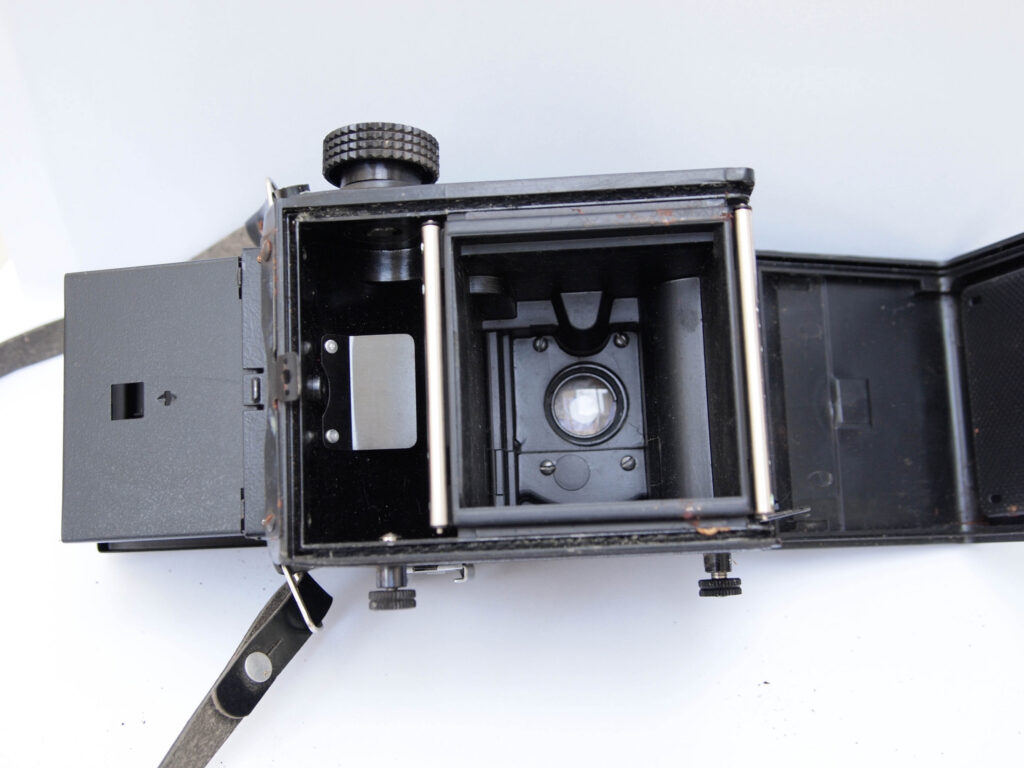Lubitel 166b TLR camera
This is another camera which I inherited from my Father – a Russian made, medium format Lubitel 166b Twin Lens Reflex.
Lubitel 166b Images










My Lubitel 166b camera
At the time of writing, this is the only twin lens reflex camera I own. It’s a very fragile looking, tin-plate and plastic affair which looks pretty poor quality, although if I look on Flickr for example pictures taken with this model of camera, it was obviously capable of some very good results.
As you can see from the pictures in this article, the top lens, which was used for focusing the picture, is very dirty and if I try to compose a picture with it now it is actually difficult to make out the image for the dirt. I don’t know if this could be removed and cleaned, but the light seals look shot and I doubt that this particular example will ever work again.
Still, from an historical point of view it is interesting because, in the same way Zenit opened the door for many people to 35 mm SLR photography, this camera made medium format photography an affordable hobby for many people.
Lubitel 166b description
The camera takes 120 film which is loaded into a reel in the bottom of the camera and runs over the back of the camera to a take-up spool sitting in the top. It was a feature of 120 film cameras that once the film was exposed you take the bottom reel off and place it in the top as the take-up reel ready for the next film.
On the Lubitel 166b, there is no film counter or wind on ratchet system to make sure you wind the correct amount of film between exposures – the film has a backing paper which has numbers on, and you wind the film until the next number shows in a small red window in the back of the camera. On this camera, there is a small blanking plate over this window and a little knob to move it out of the way when you are advancing the film.
Once the camera was loaded, the picture was composed on a glass screen fitted in the top of the camera, which you view by looking down on it from above. One advantage of this is it encouraged images taken from a lower level than eye level finders. I quite often try to take pictures from a lower height to improve the interest, so in that way this camera has an advantage.
There is a non-removable lens fitted to the Lutitel 166b – although some TLR’s had replaceable lenses, this model didn’t. It is fitted with a 75 mm f/4.5-f/22 picture lens and a coupled viewfinder lens of f/2.8. The two lenses are coupled by a gearing arrangement which keeps them in sync, and of course the aperture only applies to the bottom picture lens, so the picture you view and focus is always at maximum brightness. This arrangement is very good as long as you aren’t too close to the subject when parallax error would start to come into effect.

The shutter is a very odd arrangement. There is a small lever on one side of the lens which is brought down and when it clicks in place the shutter is ‘cocked’. There is then another lever underneath it which is pressed to release the shutter.
The aperture and shutter speed are set using small levers mounted around the lens. The range offered is
- B, 1/15, 1/30, 1/60, 1/125, 1/250 sec
- f/4.5, f/5.6, f/8, f/11, f/16, f/22
Other features of this camera are a tripod bush on the bottom, a ‘cold’ flash socket on the side with a sync socket fitted to the lens and a self-timer mechanism.
I know my dad was a camera collector like me, and I believe he bought this second hand when it was quite old. Unfortunately, he is no longer with us to confirm that now, but I’m sure he had some fun with it and that in itself is a good enough reason to buy it.
The manual for the Lubitel 166b is available on-line here.
Discover more from Everything Vintage
Subscribe to get the latest posts sent to your email.





